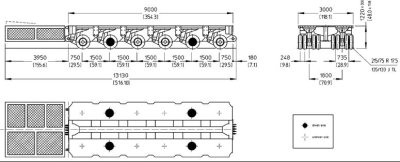Manual on Use of Self-Propelled Modular Transporters to Remove and Replace Bridges
Appendix D Example Specification for SPMT Equipment
Self-Propelled Modular Transporter (SPMT) Equipment Specification
Self-propelled modular transporters (SPMTs) are used for rapid removal and installation of bridge systems. An operator, using a computer controller connected by cables to the SPMT powerpack units, drives the SPMTs under the bridge and lifts the bridge from its supports using the SPMT hydraulic suspension system without the need of cranes or other auxiliary lifting equipment. The operator then walks with the SPMTs as the bridge is driven to its final location for exact positioning as required.
The SPMTs shall consist of four-axle units or six-axle units, with powerpacks. Each unit shall be either 8 feet (ft) (2.4 meters (m)) wide with four wheels per axle or 10 ft (3 m) wide with eight wheels per axle; the axle spacing shall not exceed 5 ft (1.5 m). The SPMT system shall be modular in nature and capable of connecting to each other both laterally and longitudinally to create the platform width and length needed to support the load; the required number of SPMT modular units is based on total weight and stability of the system. The SPMT units shall be computer linked to act together as one unit to ensure safe transport of the bridge. The SPMTs shall have a detachable powerpack module unit with a water-cooled turbo-diesel engine that activates the hydraulic pumps for drive, steering, axle compensation, and stroke. An 8-ft (2.4-m) wide six-axle unit and a 10-ft (3-m) wide six-axle unit are shown below.
The 8-ft (2.4-m) wide six-axle SPMT unit:

The 10-ft (3-m) wide six-axle SPMT unit:

The top surface of the unloaded SPMT platform at its lowest position shall be no higher than 4 ft (1.2 m) from the ground surface. Factors such as magnitude of load, tire compression, platform camber, and ground surface variation along the travel path affect the loaded SPMT platform travel height. The preferred minimum platform travel height is 44-60 inches (in) (111.7-152.4 centimeters (cm)), but the platform height may be as low as 36-50 in (91.4-127 cm) during travel.
The minimum available vertical stroke of the SPMT platform shall be approximately 24 in (60.9 cm), and the vertical lift range shall be approximately 36-60 in (91.4-152.4 cm). An available vertical stroke of 16-20 in (40.6-50.8 cm) should be assumed for operational purposes.
Each axle line shall have a minimum load capacity of 25-30 tons (23-27 metric tons), depending on unit width. The SPMT units shall be assembled in length and width to accommodate the required bridge size and weight for lifting, transporting, and setting. The SPMTs shall include lifting equipment to equally support all the beams at each span end.
The SPMTs shall be capable of traveling with the bridge load on uneven terrain having surface variations up to 18 in (45.7 cm), at up to 8 percent grade depending on ground surface friction, and with a maximum 1,500-2,000 pounds per square foot (7,323.6-9,764.8 kilogram-force per square meter) ground pressure (approximated as the load divided by the area of the platform). The loaded SPMTs shall be capable of traveling at a minimum 3 miles per hour (4.8 kilometers per hour).
The hydraulic axle compensation shall guarantee equal loads on all wheel sets, independent of the road conditions. Series-mounted safety valves shall ensure that upon a hose rupture on the wheel set, the pressure is maintained in the remaining undamaged hydraulic circuit, thus preventing one side of the platform from tilting by redistributing the load to the remaining wheel sets.
In no case shall the platform be out-of-level by more than 6 degrees during lifting, transporting, setting the bridge, or during equipment malfunction. In addition, the configuration of the SPMT must consider the location of the bridge center of gravity relative to the stability of the combined load such that out-of-level limits are established to safely avoid overturning.
The SPMTs shall have either a three-point or a four-point suspension to transport the bridge load safely. The appropriate suspension depends on the project requirements. The center of gravity must be located within the stability triangle or box to provide a safe move.
Out-of-service situations such as flats and/or failures shall be anticipated and contingencies planned accordingly to ensure that the operators can manually coordinate the units if required to complete the bridge move. The SPMT equipment shall have additional capacity to allow 5 percent of the axles to be out-of-service.
The frame (spine) and loading platform shall be welded steel construction with main longitudinal beams. The spine strength shall be adequate for the bridge load as required by the SPMT manufacturer.
The SPMT shall have all-electronic steering capability to pivot 360 degrees about its support point, allowing for normal steering, diagonal steering, crab steering, circular steering, carousel steering, and counter steering as shown below.

Each wheel set shall be controlled simultaneously by the controller. The central computer shall control all wheel sets to work independently, but together to provide for transport of large bridge loads by a series of independent, computer-linked SPMTs as shown below.
Steering of Trailers
PST-E: Centre point for steering

The SPMT operator/contractor shall have previous experience with the use of SPMTs to move bridges or comparable loads, and shall demonstrate the ability of its equipment to adequately perform job requirements.

